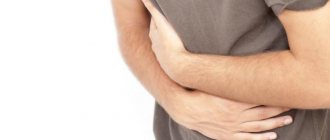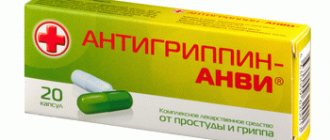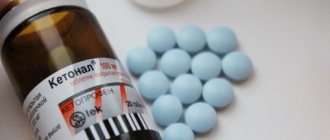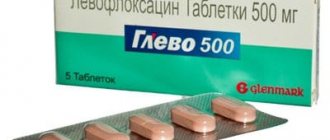With the onset of the autumn-winter season, every person is at risk of contracting the flu or ARVI. To prevent this from happening, experts recommend increasing your immunity by taking vitamins, immunostimulating drugs and a healthy lifestyle in general.
If you neglected this advice, then a medicine such as Grippostad S will help you. Instructions for using the mentioned product will be described in detail in the materials of this article. It also provides information about the form in which the medicine in question is prepared, what pharmacological properties it has, and under what conditions it should be taken.
Release form and composition
Dosage form - capsules: size No. 1, hard gelatin, opaque, with a white body and a yellow cap; contents – powder from white to white with a yellowish tint (10 pieces each in blister packs, 1 or 2 packs in a cardboard box and instructions for use of Grippostad S).
Content of active substances in 1 capsule:
- paracetamol – 200 mg;
- ascorbic acid – 150 mg;
- caffeine – 25 mg;
- chlorphenamine maleate (chlorphenamine) – 2.5 mg.
Additional components:
- excipients: gelatin, glyceryl tristearate, lactose monohydrate;
- capsule composition: body – gelatin, titanium dioxide (E 171), water; cap - gelatin, titanium dioxide (E 171), water, dyes quinoline yellow (E 104) and sunset yellow (E 110).
Indications
For what diseases is the medication “Grippostad S” (tablets) prescribed? The instructions for use inform that this drug should be used for mild or moderate pain syndrome that occurs with neuralgia, throat diseases, headaches, etc.
It must also be said that the main indications for taking the drug in question are influenza and ARVI.
Whether the drug should be used as an antipyretic drug is decided on a case-by-case basis. Typically, this depends on the severity and nature of the fever, as well as the patient's tolerance to the medication.
Pharmacological properties
Pharmacodynamics
Grippostad S is a drug of a combined composition, the components of which determine its symptomatic effect against the signs of colds.
Properties of active substances of capsules:
- paracetamol – has an antipyretic and analgesic effect;
- ascorbic acid – improves the tolerability of paracetamol and prolongs its effect (slowing elimination), increases the body’s resistance to infections. Participates in tissue regeneration, blood clotting and carbohydrate metabolism, regulation of redox processes, synthesis of steroid hormones. Reduces the need for pantothenic and folic acids, vitamins A, B1, B2, E. Reduces vascular permeability;
- caffeine – has a general tonic effect on the body, stimulates the heart, tones the blood vessels of the brain, dilates the bronchi, and has an antispasmodic effect;
- chlorphenamine - is a blocker of histamine H1 receptors, i.e. it has an antiallergic effect, which reduces nasal congestion, reduces lacrimation, sneezing and nasal discharge.
In combination, the active substances of Grippostad C reduce the symptoms of fever and malaise in acute respiratory viral infections and other colds.
Pharmacokinetics
- paracetamol: once in the gastrointestinal tract, it is quickly and completely absorbed. The maximum concentration in the blood (Cmax) is reached within 30–60 minutes. It is quickly distributed throughout most tissues of the body, penetrates the placenta and into breast milk. When used in therapeutic concentrations, it binds slightly to plasma proteins; as the concentration increases, binding increases. Subjects to primary metabolism in the liver. It is excreted from the body mainly in the urine in the form of sulfate and glucuronide compounds. The half-life (T½) is 1–3 hours. Under the influence of mixed oxidases, a hydroxylated metabolite is formed in the liver in small quantities, which is usually neutralized by binding to glutathione, but in case of overdose it can accumulate and cause liver damage;
- ascorbic acid: after oral administration, it is absorbed in the proximal small intestine. 25% bound to plasma proteins. Easily penetrates platelets and leukocytes, as well as all tissues. Reaches the highest concentration in the liver, leukocytes, and the lens of the eye. Penetrates through the placenta and into breast milk. It is metabolized mainly in the liver, where it is converted first into deoxyascorbic acid, then into oxaloacetic acid and ascorbate-2-sulfate. It is excreted unchanged and in the form of metabolites by the kidneys, through the intestines and with sweat;
- caffeine: after oral administration, it is quickly and completely absorbed. Cmax is reached between 5 and 90 minutes after administration on an empty stomach. In adults, it is eliminated almost entirely by hepatic metabolism. Individual elimination values in adults can vary greatly. The average T½ from blood plasma is 4.9 hours (can vary from 1.9 to 12.2 hours). Distributed in all body fluids. 35% bound to plasma proteins. Almost completely metabolized by acetylation, oxidation and demethylation. The main metabolites are 1-methylxanthine, 7-methylxanthine and 1,7-dimethylxanthine. Excreted by the kidneys;
- chlorphenamine: after oral administration, Cmax reaches within 1–2 hours. It has an effect for 3–6 hours. Metabolized mainly in the liver by conjugation, hydroxylation, demethylation and the formation of N- and S-oxides. Subject to first pass effect through the liver (the effect decreases with impaired liver function), so bioavailability varies between 25–50%. 69–72% bound to plasma proteins. The apparent volume of distribution is relatively high and amounts to 3–7 l/kg body weight. T½ in adults is 15–36 hours, in children – 10–13 hours, with renal failure this period increases. Depending on the pH level (acidic or alkaline), from 0 to 34% of chlorphenamine is excreted unchanged in the urine. With long-term use, the drug can accumulate in the body.
Analogs
To improve the condition of colds, you can use other drugs.
AntiFlu
Sagmel Inc (USA), Bayer (Germany)
Cost: por. (5 pcs.) – 203 RUR, por. for children (5 pcs.) – 201 rub., table. (12 pcs.) – 267 rub.,
A drug for relieving flu-like conditions: high fever, runny nose, headaches and muscle pain. The medicine is available in powder for the preparation of medicinal solutions and tablets:
- Powder for adults contains the same components that are in Grippostad S, but without ascorbic acid. It can be used for treatment from 12 years of age. It is recommended to take no more than 4 sticks per day at regular intervals.
- The composition of AntiFlu powder intended for children differs from that for adults: it contains paracetamol, ascorbic acid, chlorphenamine, and no caffeine. It can be given to children from 2 years of age. Children under 5 years old should be given a solution from one sachet per day, older children (from 5 to 12) - 2 sachets per day.
- The tablets contain a similar composition as the baby powder, but in a different dosage. They are intended for adults and children from 6 years of age. Adults are allowed to take no more than 8 pills per day; for children, the dosage is calculated individually.
Advantages:
- Good effect
- You can choose a drink or tablets.
Flaws:
- High price
- Relieves symptoms, but does not cure.
Contraindications
Absolute:
- portal hypertension;
- angle-closure glaucoma;
- severe liver and/or kidney failure;
- prostatic hyperplasia;
- alcoholism;
- glucose-galactose malabsorption, lactase deficiency, lactose intolerance;
- children under 12 years of age;
- pregnancy and lactation;
- hypersensitivity to any component of the drug.
Grippostad S capsules are used with caution in the following cases:
- stomach and duodenal ulcers;
- pyloroduodenal stenosis and bladder outlet obstruction;
- diseases accompanied by the accumulation of iron in the body (thalassemia, hemochromatosis, sideroblastic anemia);
- urolithiasis (oxalate stones);
- congenital hyperbilirubinemia (including Gilbert's syndrome);
- liver/kidney dysfunction;
- diabetes;
- chronic bronchitis or bronchial asthma;
- viral hepatitis;
- hyperoxalaturia;
- anxiety disorders;
- arrhythmias;
- hyperthyroidism;
- progressive malignant diseases;
- deficiency of glucose-6-phosphate dehydrogenase;
- elderly age;
- simultaneous use of tricyclic antidepressants, potentially hepatotoxic substances, inducers of microsomal oxidation in the liver;
- concomitant use of monoamine oxidase inhibitors (MAOIs) or their use in the previous 2 weeks before taking Grippostad S.
Cost and similar means
The general strengthening and antipyretic drug “Grippostad S” is sold in all pharmacies. You can buy this medicine at a very reasonable price. Its average cost is about 70-120 rubles.
What to do if the medication in question is contraindicated for you? What can replace the drug “Grippostad S”? Analogues of this drug are very popular among those who are susceptible to frequent respiratory diseases. These include such products as “Apap S Plus”, “Paracetamol Extra”, “Efferalgan” with vitamin C, “Mexavit”, “Daleron C”, “Daleron C Junior”, “Paracetamol-S-Hemofarm”. All of these medications significantly alleviate the patient’s condition with ARVI and influenza. However, it should be noted that their dosages may differ markedly from the dosages of Grippostad S capsules. Therefore, it is advisable to replace the mentioned medication with them only after consulting a doctor or carefully studying the attached instructions.
Side effects
The occurrence of side effects is classified according to the following gradation: very often - ≥ 1/10, often - from ≥ 1/100 to < 1/10, infrequently - from ≥ 1/1000 to < 1/100, rarely - from ≥ 1/10,000 up to <1/1000, very rarely – <1/10,000; unknown frequency - available data do not allow us to accurately estimate the frequency of adverse reactions.
Possible side effects of Grippostad S:
- from the gastrointestinal tract: often – dry mouth; very rarely – complaints from the digestive system;
- from the nervous system and psyche: very rarely – dyskinesia, psychotic reactions; unknown frequency - drowsiness, sedation, insomnia, anxiety;
- from the heart: unknown frequency - arrhythmia (for example, tachycardia);
- from the liver and biliary tract: rarely - increased activity of liver transaminases; very rarely with long-term use of the drug in high doses and in overdose - liver dysfunction, hepatotoxic effect;
- from the blood and lymphatic system: very rarely - thrombocytopenia, agranulocytosis, neutropenia, pancytopenia, leukopenia, thrombocytopenic purpura, methemoglobinemia, aplastic anemia;
- from the kidneys and urinary tract: very rarely - urinary disorders; with long-term use of Grippostad S in high doses - nephrotoxicity, kidney damage;
- from the immune system: very rarely due to the action of paracetamol - severe hypersensitivity reactions such as increased sweating, shortness of breath, nausea, anaphylactic shock, arterial hypotension, angioedema; unknown frequency - bullous skin reactions, including toxic epidermal necrolysis, Stevens-Johnson syndrome;
- on the part of metabolism and nutrition: very rarely – increased appetite;
- from the respiratory system: very rarely - respiratory hypersensitivity, bronchospasm in patients sensitive to aspirin and other non-steroidal anti-inflammatory drugs (aspirin asthma);
- from the skin and subcutaneous tissues: infrequently - allergic skin reactions (erythematous rash, urticaria), sometimes accompanied by an increase in body temperature (drug fever) and damage to the mucous membranes; very rarely - serious skin reactions (for example, acute generalized exanthematous pustulosis);
- from the organ of vision: very rarely - visual disorders, angle-closure glaucoma; unknown frequency – mydriasis;
- laboratory and instrumental data: unknown frequency - decreased results of skin allergy tests (under the influence of chlorphenamine), distortion of laboratory tests, including quantitative determination of glucose and uric acid in plasma (under the influence of paracetamol), determination of glucose, creatinine, uric acid in blood and urine acids and inorganic phosphates, false negative results when testing feces for occult blood (when taking ascorbic acid in doses of more than 1000 mg).
Reviews
The drug "Grippostad S" is far from the most popular remedy that is used during the season of colds and respiratory diseases. However, it also has its own consumer.
Patients report that taking such capsules allows them to quickly eliminate elevated body temperature, as well as all the symptoms of ARVI, which manifest themselves in the form of nasal congestion, headaches and sore throat.
To prevent the occurrence of adverse reactions and symptoms of overdose, be sure to consult an experienced doctor before using this product. After all, only a specialist, based on test data and the patient’s condition, will be able to select the appropriate dosage of the drug and the treatment regimen as a whole.
Overdose
In case of an overdose of Grippostad C, the symptoms are a complex of signs of an overdose of individual components of the drug.
Paracetamol
Symptoms: lack of appetite, nausea, vomiting, abdominal pain, pale skin (appear within 24 hours from the moment of overdose). This is usually followed by subjective improvement, but moderate abdominal pain persists, indicating liver damage.
After taking a high dose, there is an increase in the level of liver transaminases, bilirubin and lactate dehydrogenase, as well as an increase in thromboplastin time (12–48 hours after administration). With a single dose of more than 6000 mg in adults and a dose of 140 mg/kg in children, liver necrosis develops, which can lead to irreversible total necrosis, and later to encephalopathy, metabolic acidosis (including lactic acidosis), and hepatocellular failure. Subsequently, these disorders can cause coma and death.
Clinical symptoms of liver damage appear after 3 days, reaching a peak after 4–6 days.
Even in the absence of severe liver damage, acute renal failure with acute tubular necrosis may develop.
Symptoms not related to liver function: pancreatitis, myocardial disorders.
The risk of overdose is especially high in the following cases:
- elderly age;
- presence of liver diseases;
- chronic alcoholism;
- chronic eating disorder;
- use of inducers of microsomal liver enzymes.
In these categories of patients, an overdose is fraught with death.
The overdose threshold may be lowered in children and malnourished patients.
Ascorbic acid
After a single dose of 3000 mg, transient osmotic diarrhea, accompanied by abdominal symptoms, may develop, and after taking 10,000 mg, transient osmotic diarrhea almost always develops.
In predisposed patients, the formation of oxalate kidney stones may increase.
In patients with glucose-6-phosphate dehydrogenase deficiency, high doses of ascorbic acid (more than 4000 mg) can cause hemolysis.
Caffeine
A dose of more than 1000 mg, taken over a short period of time, causes symptoms of intoxication such as tremor, disorders of the cardiovascular system (myocardial damage, tachycardia) and reactions from the central nervous system.
Chlorphenamine
In case of overdose, an anticholinergic syndrome develops, accompanied by dry mouth, increased body temperature, dilated pupils, redness of the face, constipation, hallucinations, anxiety, ataxia, muscle tremors, and convulsions.
In the future, symptoms from the central nervous system may develop: loss of coordination, hallucinations, convulsions.
In severe cases, coma occurs, breathing stops, and cardiovascular collapse develops.
If the dose of Grippostad C is significantly exceeded, treatment is prescribed aimed at eliminating the developed disorders.
Mode of application
Capsules are taken orally by adults and adolescents from 12 years of age. The treatment regimen should be determined by the doctor based on the patient’s individual indications. If it is not possible to get a prescription, then Grippostad S should be taken according to the scheme outlined in the instructions for use: 3 times a day, 2 capsules, regardless of meals. It is important to maintain a time interval between doses - at least four hours. The largest number of tablets that can be taken during the day is 12 pieces.
For self-treatment, the course should not exceed 3-5 days. After this time, the capsules should be discontinued, and if your health does not improve, see a doctor.
People who have problems with the liver and kidneys need to adjust the frequency of taking and dosage of the drug: increase the interval between use or reduce the dosage of Grippostad S. In no case should you increase the number of tablets on your own.
special instructions
With long-term use of Grippostad C, headaches may occur that cannot be relieved by increasing the dose of the drug.
Paracetamol in doses higher than recommended may cause serious liver damage. To avoid the possibility of overdose, you should not simultaneously take other medications that contain paracetamol. For patients weighing more than 43 kg, the maximum daily dose of paracetamol should not exceed 4000 mg.
You should also refrain from taking additional ascorbic acid. In high doses in predisposed patients, it may increase the formation of oxalate kidney stones. With a deficiency of glucose-6-phosphate dehydrogenase, ascorbic acid in a daily dose of 4000 mg in some cases leads to the development of hemolysis.
During the treatment period, you should not drink alcoholic beverages, since the combination of Grippostad C and ethanol can cause toxic damage to the liver.
Impact on the ability to drive vehicles and complex mechanisms
During drug therapy, dizziness and drowsiness may develop, so it is recommended not to perform potentially dangerous work during this period, including driving a car.
Use during pregnancy and lactation
Epidemiological studies have found that the use of chlorphenamine during pregnancy increases the risk of developing abnormalities in the fetus of the central nervous system, as well as tumors and cranial anomalies in childhood. Another study suggests that there is an increased risk of retrolental fibroplasia in premature infants whose mothers took antihistamines in the last 2 weeks before delivery. In this regard, pregnant women are prohibited from taking Grippostad S.
If treatment is required during lactation, women should temporarily stop breastfeeding.
Grippostad
Active substance:
Paracetamol*, Ascorbic acid*
Pharmgroup:
Anilides in combinations
Average price in pharmacies
| Name | Manufacturer | average price |
| Grippostad with n10 caps | Stada Artsneimittel AG | 113.00 |
Analogs for the active substance:Daleron C Daleron C junior Meksavit Paracetamol-S-Hemofarm Efferalgan with vitamin C | Application area:Bacterial infections of the upper respiratory tract Bacterial respiratory infections Pain syndrome in muscular and joint diseases Pain syndrome in muscular and joint diseases Pain syndrome with neuralgia Pain syndrome in osteoarthritis Pain syndrome in osteoarthritis Pain syndrome in acute inflammatory diseases of the musculoskeletal system Pain syndrome due to smooth muscle spasms Pain syndrome due to smooth muscle spasms (renal and biliary colic, intestinal spasms, dysmenorrhea) Pain syndrome due to spasms of smooth muscles of internal organs Pain syndrome due to spasms of smooth muscles of internal organs (renal and biliary colic, intestinal spasms, dysmenorrhea) Pain syndrome in chronic inflammatory diseases of the musculoskeletal system Pain syndrome in chronic inflammatory diseases of the musculoskeletal system Pain in the muscles Pain in the joints Pain during menstruation Pain syndromes in dental practice Muscle soreness Muscle soreness during heavy physical activity Joint pain Joint pain during heavy physical activity Painful inflammatory joint lesions Painful, irregular periods Painful conditions of the musculoskeletal system Painful conditions of the musculoskeletal system Painful joint conditions Painful traumatic joint lesions Pain in the musculoskeletal system Pain in the musculoskeletal system Muscle pain Shoulder pain Pain at rest Joint pain Dentin pain Muscle pain Pain during menstruation Pain during menstruation Viral respiratory disease Pain due to colds Viral respiratory tract infections Pulp pain Muscle pain Joint pain Joint pain due to injury Musculoskeletal pain Musculoskeletal pain Pain after tartar removal Pain after dental procedures Pain in infectious and inflammatory diseases of the upper respiratory tract Osteoarthritis pain Pain due to joint pathology Rheumatoid arthritis pain Pain in chronic degenerative bone diseases Pain in chronic degenerative joint diseases Pain during tooth extraction Inflammatory disease of the upper respiratory tract Inflammatory diseases of the upper respiratory tract Inflammatory diseases of the upper respiratory tract with difficult to separate sputum Inflammatory diseases of the respiratory tract Secondary infections with influenza Secondary infections due to colds Hyperthermia malignant Influenza conditions Dentin pain Dysalgomenorrhea Dysmenorrhea Dysmenorrhea (essential) (exfoliative) Difficulty secreting sputum in acute and chronic respiratory diseases Occipital and intercostal neuralgia Malignant hyperthermia Toothache Upper respiratory tract infections Upper respiratory tract infections Respiratory tract infections Respiratory and lung infections ENT infections Infectious and inflammatory diseases of the upper respiratory tract Infectious and inflammatory diseases of the upper respiratory tract and ENT organs Infectious and inflammatory diseases of the upper respiratory tract in adults and children Infectious and inflammatory diseases of the upper respiratory tract Infectious inflammation of the respiratory tract Respiratory tract infection Qatar of the upper respiratory tract Catarrhal inflammation of the upper respiratory tract Catarrhal disease of the upper respiratory tract |
Drug interactions
Paracetamol
- drugs that slow down gastric emptying (for example, propantheline): it is possible to reduce the rate of absorption of paracetamol and, as a result, slow down its action;
- drugs that accelerate gastric emptying (for example, metoclopramide): it is possible to accelerate the absorption of paracetamol and, as a result, an earlier onset of its action;
- zidovudine: the risk of developing neutropenia increases (when using this combination, careful medical supervision is required);
- salicylamides: the half-life of paracetamol increases;
- cholestyramine: absorption of paracetamol decreases;
- probenecid: the clearance of paracetamol is reduced by approximately 2 times (if it is necessary to use this combination, the dose of paracetamol should be reduced);
- anticoagulants: with irregular use of paracetamol there are no reactions, with long-term use of paracetamol (for several weeks) the effect of anticoagulants increases.
Caffeine
- antihistamines, barbiturates: their sedative effect is reduced;
- theophylline: its excretion decreases;
- barbiturates, nicotine: caffeine metabolism accelerates;
- quinolone DNA gyrase inhibitors: the excretion of caffeine and its metabolite paraxanthine may be slowed down;
- disulfiram, cimetidine, oral contraceptives: the metabolism of caffeine in the liver decreases;
- thyroxine, sympathomimetics: possible increase in tachycardia;
- broad-spectrum drugs (for example, benzodiazepines): unpredictable drug interactions may develop.
Chlorphenamine
When used simultaneously with chlorphenamine, antidepressants or ethanol potentiate the sedative effect.
Ascorbic acid
There is no data on drug interactions with ascorbic acid.
Compatibility with other tools
Is it possible to combine Grippostad S capsules with other drugs? The instructions (tablets should be prescribed only by an experienced doctor) indicate that this medication is not recommended to be combined with NSAIDs. It is also undesirable to take it with Levomycetin, barbiturates, Rifampicin and antiepileptic drugs.
The combination of this drug with Metoclopramide can lead to accelerated absorption of paracetamol from the intestine. The opposite effect is produced by the drug Cholestyramine.
The toxicity of an active substance such as paracetamol increases significantly under the influence of Probenecid, as well as drugs that induce liver enzymes, salicylates and drugs with hepatotoxic effects.
In addition, it should be noted that paracetamol may enhance the effect of oral anticoagulants.
In combination with antipsychotics, hypnotics, tranquilizers and other drugs that depress the central nervous system, the effect of chlorpheniramine on the nervous system may increase. It should also be noted that the mentioned substance increases the therapeutic effect of antiparkinsonian drugs, antispasmodics, tricyclic antidepressants and Atropine.
The combination of Grippostad S with Zidovudine should be very careful.
The concentration of caffeine in the blood increases when taken simultaneously with nicotine and barbiturates and, conversely, decreases when interacting with Disulfiram, oral contraceptives and Cimetidine.
It should also be said that caffeine increases the additive potential of the components of the ephedrine series, as well as the content of “Theophylline” in the blood.
Absorption of ascorbic acid is reduced when combined with oral contraceptives, alkaline juices and drinks.
It should also affect the effect of indirect anticoagulants and Heparin. When combined with salicylates, the likelihood of developing crystalluria increases. In addition, when prescribing the drug in question together with Deferoxamine, the absorption of tetracyclines, penicillin and iron from the intestines increases, and the risk of their toxic effects on the patient’s body increases.









